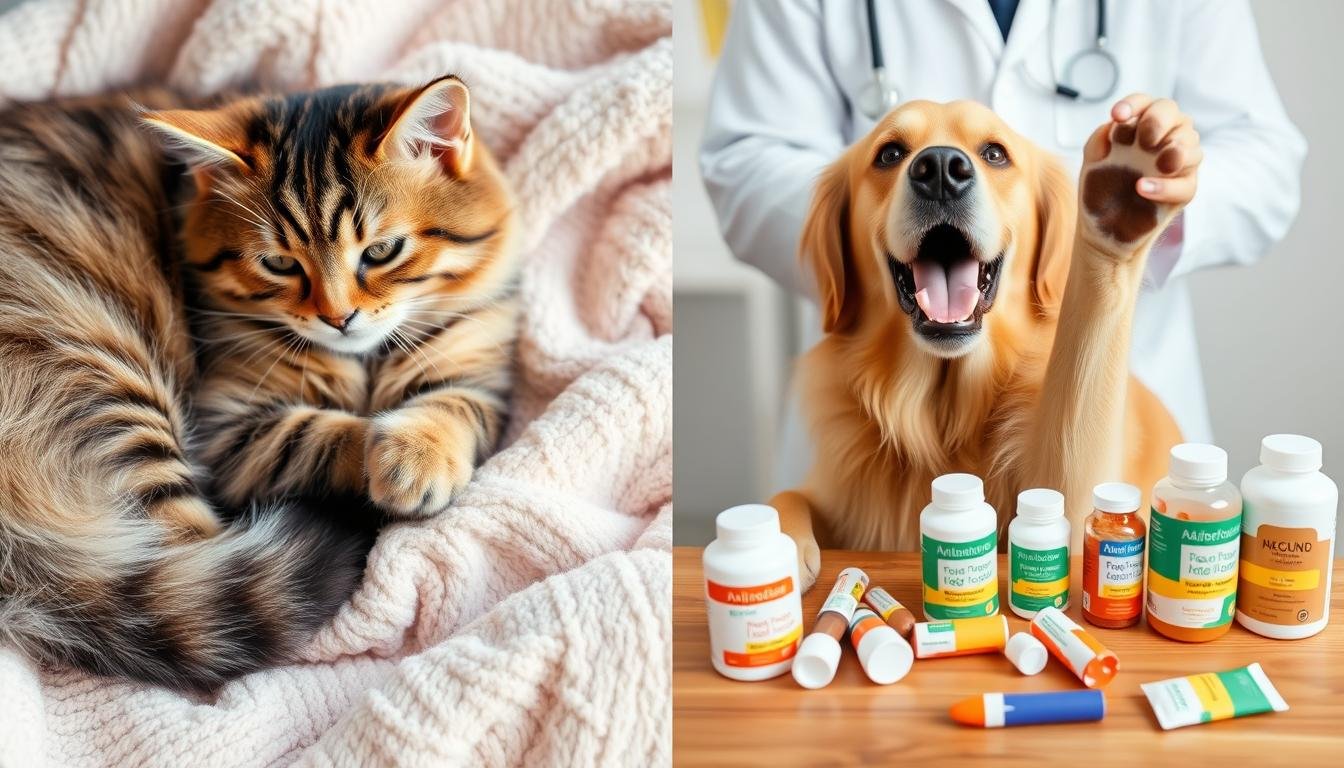As a pet owner, it’s key to know the signs of allergies in pets. Taking quick action is important for your pet’s health. Good pet care helps prevent allergies and keeps pets happy.
Allergies can hit any pet, no matter their age, breed, or size. It’s crucial to know the common allergies pets face.
Whether you have a dog, cat, or other pet, knowing about allergies is vital. By spotting allergy causes and symptoms, you can prevent and treat them. This ensures your pet stays happy and healthy.
Good pet care means knowing about allergens and how to reduce them. This helps keep your pet safe from harm.
Key Takeaways
- Common allergies in pets can be caused by environmental factors, food, or skin irritants
- Providing proper pet care involves being aware of potential allergens and taking steps to prevent them
- Recognizing the signs and symptoms of allergies is crucial to ensuring your pet’s health and well-being
- Pets of all ages, breeds, and sizes can be affected by allergies
- Proper pet care and awareness of common allergies can help prevent and treat allergies in pets
Understanding Pet Allergies: An Overview
Pet allergies can be a big problem for many animals, like dogs. Allergies happen when the immune system reacts too strongly to something harmless, like pollen or dust. This can cause symptoms ranging from mild to very serious. As a pet owner, knowing about allergies is key to improving your pet’s life.
Many things can cause allergies in pets, like environmental allergens, food, and skin irritants. Dogs might get allergies from certain foods, like beef or dairy. Or they might react to things in the air, like pollen or dust mites. Knowing what causes allergies helps you care for your pet better.
Common signs of allergies in pets include itching, scratching, and skin issues. In bad cases, allergies can cause breathing problems, like coughing and wheezing. If you think your pet has an allergy, seeing a vet is important. They can help your pet feel better and live a happy life.
What Causes Allergies in Pets
- Environmental allergens, such as pollen and dust mites
- Food allergies, such as reactions to certain ingredients
- Skin irritants, such as flea bites or skin infections
Most Common Types of Pet Allergies
Pet allergies can be broken down into skin, food, and environmental allergies. Each type needs a different treatment plan. Working with your vet, you can find ways to help your pet with their allergies. This way, they can live a happy and healthy life.
Recognizing the Warning Signs of Pet Allergies
As a pet owner, it’s key to spot the signs of pet allergies early. This helps you treat your cats and other pets quickly and well. Common signs include itching, scratching, and breathing problems.
Looking for identifying allergies in your pet? Watch for these signs:
- Changes in behavior, such as increased scratching or restlessness
- Physical signs, such as redness, inflammation, or skin irritation
- Respiratory issues, such as coughing or sneezing
Knowing these signs lets you act fast to help your pet. You might need to see a vet and change your pet’s environment or diet. With the right pet supplies and care, your cats and other pets can be happy and healthy.
It’s vital to recognize pet allergy signs to give your pet the best care. By staying informed and taking action, you can help your pet live a long, healthy life.
| Pet Allergy Symptoms | Description |
|---|---|
| Itching and scratching | Excessive scratching or chewing, often accompanied by redness and inflammation |
| Respiratory issues | Coughing, sneezing, or difficulty breathing, often accompanied by wheezing or panting |
Environmental Allergies in Pets: The Hidden Culprits
As a pet owner, it’s key to think about environmental allergies and their impact on your pet’s health. When adopting a pet, consider the allergens in your home. These can affect your new pet’s well-being.
Common allergens include pollen, mold, dust, and chemicals. They can be found indoors and outdoors. It’s important to reduce their impact on your pet’s health.
Here are some ways to identify and mitigate environmental allergens:
- Use HEPA filters to reduce dust and pollen in your home
- Remove mold and mildew from surfaces and fabrics
- Avoid using chemical-based cleaning products
By taking these steps, you can make your home healthier for your pet. This reduces the risk of environmental allergies. Remember, every pet is unique. So, watch your pet’s health closely and adjust your approach as needed. With the right strategies, your pet can thrive and enjoy good health.
| Common Environmental Allergens | Sources | Mitigation Strategies |
|---|---|---|
| Pollen | Outdoors, plants, and trees | Use HEPA filters, remove plants from home |
| Mold | Damp surfaces, fabrics, and carpets | Remove mold and mildew, use dehumidifiers |
| Chemicals | Cleaning products, pesticides, and fertilizers | Avoid using chemical-based products, opt for natural alternatives |
Food Allergies and Dietary Sensitivities
Food allergies and sensitivities can really hurt a pet’s life, causing tummy troubles and skin issues. It’s key to get pet insurance that covers these problems. This way, you won’t have to worry about the cost of keeping your pet healthy.
Beef, dairy, soy, and wheat are common culprits for pet allergies. To figure out what’s causing the allergy, you might need to try a special diet or get blood tests from a vet. Knowing what foods are bad for your pet helps you feed them right.
Here are some important tips for dealing with food allergies and sensitivities in pets:
- Work with a vet to create a special diet plan for your pet.
- Keep an eye on your pet’s symptoms and change their diet if needed.
- Look into pet insurance that covers food allergies and sensitivities.
By being proactive about your pet’s allergies, you can make sure they’re happy and healthy. Always talk to a vet before changing your pet’s diet or insurance.
Skin Allergies and Dermatological Issues
As a pet owner, knowing about skin allergies in pets is key. These allergies can make your pets very uncomfortable. It’s important to take good care of them to prevent and manage these issues.
Skin allergies in pets can be mild or severe. Symptoms include itching, scratching, and infections. These problems can be caused by many things, like environmental allergens, flea bites, and genetics.
To tackle skin allergies in pets, you need to work with a vet. They’ll help find out what’s causing the problem. This might involve tests like skin scrapings or blood tests.
Once the cause is known, a treatment plan can be made. This might include creams, pills, or changes in your pet’s lifestyle.
Here are some ways to prevent skin allergies in pets:
- Regular grooming to reduce flea risks
- Using hypoallergenic shampoos and conditioners
- Avoiding environmental allergens
By following these tips, you can lower the chance of skin allergies in your pets. This will help them stay happy and healthy.
Professional Diagnosis Methods for Pet Allergies
Identifying allergies in animals, especially dogs, requires a professional touch. Veterinarians employ skin tests and blood tests to find the root cause of allergies. These tests pinpoint the allergens causing the allergic reaction in your pet.
Getting a thorough diagnosis is key to creating an effective treatment plan. With a vet’s help, your pet can get the care they need to manage their allergies. Common diagnostic methods include:
- Skin tests to identify specific allergens
- Blood tests to measure antibody levels
- Elimination diets to identify food allergies
Knowing about the diagnostic process helps you make better decisions for your pet’s health. Recognizing the importance of professional diagnosis is a big step towards a happy, healthy life for your dogs and other animals.
Treatment Options and Management Strategies
Managing pet allergies involves several treatment options and strategies. These can help reduce symptoms and improve your pet’s life. For cats, it’s key to work with your vet to create a plan that fits their needs.
Some pet owners try natural remedies like omega-3 fatty acids and probiotics. These can be found in pet food and supplements. But, always talk to your vet before adding new supplements to your pet’s diet.
Medical Treatments
Medical treatments, such as antihistamines and corticosteroids, can ease allergy symptoms. Your vet can guide you on the best treatment for your pet.
Natural Remedies
Natural remedies, like acupuncture and herbal supplements, can also help manage allergies. Some pet owners have seen positive results. But, it’s important to talk to your vet before trying new treatments.
Lifestyle Modifications
Making lifestyle changes can also help manage allergies. For example, switching to a hypoallergenic diet or using HEPA air purifiers can reduce allergen exposure.
By working with your vet and exploring different treatments, you can help your pet live a happy, healthy life. This life will be free from the discomfort of allergies.
| Treatment Option | Description |
|---|---|
| Medical Treatments | Antihistamines, corticosteroids, and other medications |
| Natural Remedies | Omega-3 fatty acids, probiotics, acupuncture, and herbal supplements |
| Lifestyle Modifications | Dietary changes, environmental adjustments, and stress reduction techniques |
Preventing Allergic Reactions in Your Pets
As a responsible pet owner, it’s key to prevent allergic reactions in your pets. You can do this by controlling their environment, managing their diet, and keeping an eye on their health. This helps keep your pet safe and happy, especially after adopting a new pet.
Keeping an eye on your pet’s health is very important. Make sure to take them to the vet regularly and get blood tests to check for allergies. This way, you can catch any problems early and help your pet stay healthy.
- Keeping your home clean and dust-free
- Using hypoallergenic products and bedding
- Providing a balanced and nutritious diet
- Avoiding exposure to known allergens
By following these steps and working with your vet, you can prevent allergic reactions in your pets. This ensures they live happy and healthy lives, which is the main goal of pet adoption and caring for pets.
| Prevention Method | Description |
|---|---|
| Environmental Controls | Reducing exposure to allergens in the environment |
| Dietary Management | Providing a balanced and nutritious diet |
| Regular Health Monitoring | Scheduling regular check-ups and conducting blood tests |
When to Seek Emergency Veterinary Care
As a pet owner, knowing when your pet needs urgent care is key. Severe pet allergies can be deadly. Look out for signs like difficulty breathing, severe skin reactions, and anaphylaxis. These are emergencies that need quick action.
Having pet insurance can give you peace of mind and protect your wallet. It’s important to know when to get emergency care. You can choose from emergency clinics to veterinary hospitals. Being ready and knowing when to act can save your pet’s life.
In emergencies, time is of the essence. If you’re not sure about your pet’s health, it’s safer to get them to a vet right away. Your pet’s safety depends on it. The right pet insurance can be a lifesaver.
Conclusion: Creating a Happy, Allergy-Free Life for Your Pet
In this final section, we’ve explored how to help your pets live without allergies. Understanding what causes pet allergies and knowing the signs is key. Working with your vet helps you make a plan to stop allergic reactions.
Identifying what triggers allergies and fixing diet issues are important steps. By using the tips from this article, your pet can feel better. They’ll enjoy a better life.
Keeping your pet healthy is a team effort. Use online groups and vet clinics for help. With care and the right steps, you can make a happy, healthy home for your pet.












